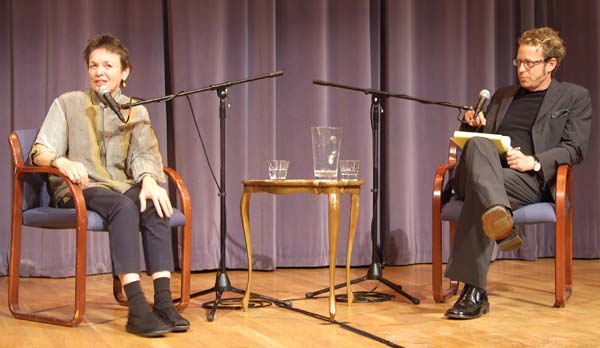 Laurie Anderson and Ken Goldberg (Zhang Yan / IEOR department, UC Berkeley)
Laurie Anderson and Ken Goldberg (Zhang Yan / IEOR department, UC Berkeley)Homeland insecurity
Storyteller and musician Laurie Anderson on art and technology
| 29 October 2008
BERKELEY — “There’s trouble in the mine,” intoned Laurie Anderson during Homeland, a work she performed at Zellerbach Hall last Friday and Saturday nights. The piece was co-commissioned by Cal Performances.
While spelling out what that troubled mine symbolizes is not Anderson’s style, over the course of 100 minutes the avant-garde musician made wryly humorous and pointed observations about this country’s collective amnesia, our national identity, consumerism writ large, disorientation, and death. On a stage lit with candles and bulbs suspended several feet in the air, Anderson talked, sang, and played violin and keyboards, accompanied by a second keyboard player, a bassist, and a cellist.
Between the two performances of Homeland, Anderson spoke in Wheeler Hall with Ken Goldberg, director of Berkeley’s Center for New Media, in a discussion that touched on artistic freedom, technology, and the role of artists.
Laurie Anderson in verse and conversation
Technology was the thread that tied together every aspect of Anderson’s visit to Berkeley. While here, she virtually joined her husband, musician/poet Lou Reed, to reprise an event “Made In Catalunya” in which they had read Catalan poetry in New York last year. In a collaboration between Educational Technology Services and Cal Performances, Anderson read poems from the campus’s broadcast studio in Dwinelle Hall, and her performance was transmitted via the Internet to a big screen at KOSMOPOLIS International Literature Fest where Reed appeared. View their 45-minute performance.
The Art, Technology, and Culture Colloquium with Anderson will be posted in the near future on Berkeley Center for New Media’s website.
Anderson, who at 61 doesn’t look her age, has been employing technology in her work for four decades. Her diverse CV reflects her varied talents: she’s recorded several albums; performed large-scale theatrical multimedia works that combine music, video, and storytelling; appeared in her own concert film, Home of the Brave; and collaborated with artists as varied as William Burroughs, Robert Wilson, Spalding Gray, and Peter Gabriel.
In her discussion with Goldberg — part of the Art, Technology, and Culture Colloquium series — Anderson was charming, funny, and often disarming. She traced the genesis of Homeland to a film she made for Japan’s 2005 World Expo that included a story about losing things. Anderson’s translator had asked her what she had misplaced. After thinking about it, the artist homed in on her sickening feeling of what was missing. “What I had lost was my country,” said Anderson.
“Homeland” is “not an American word,” explained Anderson, but “a fascist term” like “fatherland.” It deceptively suggests notions of cookies and warmth, she said, “though everybody knows it’s not warm at all.”
“We have an extremely story-savvy government” that spins tales very consciously, Anderson charged. A year ago, she recalled, there was “all this saber-rattling going on” to convince the American public of the need to invade Iran. Some of the public, she said, bought into that narrative. Such a story doesn’t have to be true, she said; it just has to be a good story with “an evil dictator and a hidden treasure.”
Technology can get in the way
Back in 1981, Anderson had an improbable hit with her song “O Superman (For Massenet).” It was written at around the time of the Iranian hostage crisis, she recalled, “at the beginning of a war that’s still going on.” The U.S. was trying to rescue its captive citizens by using helicopters, and the helicopters crashed in the desert. The song “is about how technology can’t save you,” she explained.
An audience member asked Anderson whether technology ever gets in the way of making art. “All the time,” she replied. “It depends on how you hold it.” Technology is a means to create certain things, she said, adding that its use doesn’t improve or diminish a piece of art.
Goldberg asked Anderson whether she sees herself as an artistic conduit or medium. “I see myself as more of a pointer,” she answered. She steers her audience’s attention to “things that are not that unusual or weird,” but that she sees “from a slightly different point of view.”
Nor does she view herself as an artist charged with making the world a better place — although if that occurs, it’s great, she says. But prioritizing it “makes it into something missionary and creepy.” Anderson’s hope is “to just tell some stories and leave it at that.”

